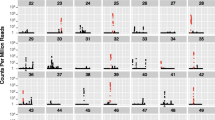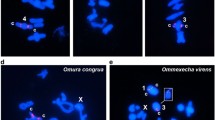Abstract
Previous studies have shown that the eukaryotic microbe Euglena gracilis contains an unusually large assortment of small nucleolar RNAs (snoRNAs) and ribosomal RNA (rRNA) modification sites. However, little is known about the evolutionary mechanisms contributing to this situation. In this study, we have examined the organization and evolution of snoRNA genes in Euglena with the additional objective of determining how these properties relate to the rRNA modification pattern in this protist. We have identified and extensively characterized a clustered pattern of genes encoding previously biochemically isolated snoRNA sequences in E. gracilis. We show that polycistronic transcription is a prevalent snoRNA gene expression strategy in this organism. Further, we have identified 121 new snoRNA coding regions through sequence analysis of these clusters. We have identified an E. gracilis U14 snoRNA homolog clustered with modification-guide snoRNA genes. The U14 snoRNAs in other eukaryotic organisms examined to date typically contain both a modification and a processing domain. E. gracilis U14 lacks the modification domain but retains the processing domain. Our analysis of U14 structure and evolution in Euglena and other eukaryotes allows us to propose a model for its evolution and suggest its processing role may be its more important function, explaining its conservation in many eukaryotes. The preponderance of apparent small and larger-scale duplication events in the genomic regions we have characterized in Euglena provides a mechanism for the generation of the unusually diverse collection and abundance of snoRNAs and modified rRNA sites. Our findings provide the framework for more extensive whole genome analysis to elucidate whether these snoRNA gene clusters are spread across multiple chromosomes and/or form dense “arrays” at a limited number of chromosomal loci.







Similar content being viewed by others
Notes
Variable annealing temperature was altered for different primer combinations.
References
Bachellerie JP, Cavaille J, Huttenhofer A (2002) The expanding snoRNA world. Biochimie 84(8):775–790
Barneche F, Gaspin C, Guyot R, Echeverria M (2001) Identification of 66 box C/D snoRNAs in Arabidopsis thaliana: extensive gene duplications generated multiple isoforms predicting new ribosomal RNA 2′-O-methylation sites. J Mol Biol 311(1):57–73
Brown JW, Echeverria M, Qu LH (2003) Plant snoRNAs: functional evolution and new modes of gene expression. Trends Plant Sci 8(1):42–49
Charette JM, Gray MW (2009) U3 snoRNA genes are multi-copy and frequently linked to U5 snRNA genes in Euglena gracilis. BMC Genomics 10:528
Decatur WA, Fournier MJ (2003) RNA-guided nucleotide modification of ribosomal and other RNAs. J Biol Chem 278(2):695–698
Dieci G, Preti M, Montanini B (2009) Eukaryotic snoRNAs: a paradigm for gene expression flexibility. Genomics 94(2):83–88
Dunbar DA, Wormsley S, Lowe TM, Baserga SJ (2000) Fibrillarin-associated box C/D small nucleolar RNAs in Trypanosoma brucei. Sequence conservation and implications for 2′-O-ribose methylation of rRNA. J Biol Chem 275(19):14767–14776
Ganot P, Bortolin ML, Kiss T (1997) Site-specific pseudouridine formation in preribosomal RNA is guided by small nucleolar RNAs. Cell 89(5):799–809
Gupta SK, Hury A, Ziporen Y, Shi H, Ullu E, Michaeli S (2010) Small nucleolar RNA interference in Trypanosoma brucei: mechanism and utilization for elucidating the function of snoRNAs. Nucleic Acids Res 28(15):2855–2861
Jarmolowski A, Zagorski J, Li HV, Fournier MJ (1990) Identification of essential elements in U14 RNA of Saccharomyces cerevisiae. EMBO J 9(13):4503–4509
Jiang G, Chen X, Li W, Jin Y, Wang D (2002) Identification and characterization of a novel U14 small nucleolar RNA gene cluster in Oryza sativa. Gene 294(1–2):187–196
Kenmochi N, Higa S, Yoshihama M, Tanaka T (1996) U14 snoRNAs are encoded in introns of human ribosomal protein S13 gene. Biochem Biophys Res Commun 228(2):371–374
Kiss T (2001) Small nucleolar RNA-guided post-transcriptional modification of cellular RNAs. EMBO J 20(14):3617–3622
Kiss T (2002) Small nucleolar RNAs: an abundant group of noncoding RNAs with diverse cellular functions. Cell 109(2):145–148
Kruszka K, Barneche F, Guyot R, Ailhas J, Meneau I, Schiffer S, Marchfelder A, Echeverria M (2003) Plant dicistronic tRNA-snoRNA genes: a new mode of expression of the small nucleolar RNAs processed by RNase Z. EMBO J 22(3):621–632
Lafontaine DL, Tollervey D (2001) The function and synthesis of ribosomes. Natl Rev Mol Cell Biol 2(7):514–520
Li HD, Zagorski J, Fournier MJ (1990) Depletion of U14 small nuclear RNA (snR128) disrupts production of 18S rRNA in Saccharomyces cerevisiae. Mol Cell Biol 10(3):1145–1152
Liang WQ, Clark JA, Fournier MJ (1997) The rRNA-processing function of the yeast U14 small nucleolar RNA can be rescued by a conserved RNA helicase-like protein. Mol Cell Biol 17(7):4124–4132
Liang XH, Uliel S, Hury A, Barth S, Doniger T, Unger R, Michaeli S (2005) A genome-wide analysis of C/D and H/ACA-like small nucleolar RNAs in Trypanosoma brucei reveals a trypanosome-specific pattern of rRNA modification. RNA 11(5):619–645
Maden BE (1990) The numerous modified nucleotides in eukaryotic ribosomal RNA. Prog Nucleic Acid Res Mol Biol 39:241–303
Maxwell ES, Fournier MJ (1995) The small nucleolar RNAs. Annu Rev Biochem 64:897–934
Michaud M, Cognat V, Duchene AM, Marechal-Drouard L (2011) A global picture of tRNA genes in plant genomes. Plant J 66(1):80–93
Ni J, Tien AL, Fournier MJ (1997) Small nucleolar RNAs direct site-specific synthesis of pseudouridine in ribosomal RNA. Cell 89(4):565–573
Omer AD, Ziesche S, Decatur WA, Fournier MJ, Dennis PP (2003) RNA-modifying machines in archaea. Mol Microbiol 48(3):617–629
Qu LH, Henras A, Lu YJ, Zhou H, Zhou WX, Zhu YQ, Zhao J, Henry Y, Caizergues-Ferrer M, Bachellerie JP (1999) Seven novel methylation guide small nucleolar RNAs are processed from a common polycistronic transcript by Rat1p and RNase III in yeast. Mol Cell Biol 19(2):1144–1158
Russell AG, Schnare MN, Gray MW (2004) Pseudouridine-guide RNAs and other Cbf5p-associated RNAs in Euglena gracilis. RNA 10(7):1034–1046
Russell AG, Schnare MN, Gray MW (2006) A large collection of compact box C/D snoRNAs and their isoforms in Euglena gracilis: Structural functional and evolutionary insights. J Mol Biol 357(5):1548–1565
Schnare MN, Gray MW (1990) Sixteen discrete RNA components in the cytoplasmic ribosome of Euglena gracilis. J Mol Biol 215(1):73–83
Schnare MN, Gray MW (2011) Complete modification maps for the cytosolic small and large subunit rRNAs of Euglena gracilis: functional and evolutionary implications of contrasting patterns between the two rRNA components. J Mol Biol. doi:10.1016/j.jmb.2011.08.037
Simpson AG, Roger AJ (2004) Protein phylogenies robustly resolve the deep-level relationships within Euglenozoa. Mol Phylogenet Evol 30(1):201–212
Uliel S, Liang XH, Unger R, Michaeli S (2004) Small nucleolar RNAs that guide modification in trypanosomatids: repertoire, targets, genome organisation, and unique functions. Int J Parasitol 34(4):445–454
von der Heyden S, Chao EE, Vickerman K, Cavalier-Smith T (2004) Ribosomal RNA phylogeny of bodonid and diplonemid flagellates and the evolution of euglenozoa. J Eukaryot Microbiol 51(4):402–416
Xu Y, Liu L, Lopez-Estrano C, Michaeli S (2001) Expression studies on clustered trypanosomatid box C/D small nucleolar RNAs. J Biol Chem 276(17):14289–14298
Yuan G, Klambt C, Bachellerie JP, Brosius J, Huttenhofer A (2003) RNomics in Drosophila melanogaster: identification of 66 candidates for novel non-messenger RNAs. Nucleic Acids Res 31(10):2495–2507
Zhang JZ (2003) Evolution by gene duplication: an update. Trends Ecol Evol 18(6):292–298
Acknowledgments
This work was supported by Discovery Grant funding to AGR from the Natural Sciences and Engineering Research Council of Canada (NSERC). ANM was supported by an NSERC CGS-M Graduate Fellowship. We would like to thank Michael Gray (Dalhousie University) in whose lab this project was initiated and Murray Schnare (Dalhousie University) for his assistance in initially identifying the Euglena U14 snoRNA and sharing his rRNA nucleotide modification mapping data before publication.
Author information
Authors and Affiliations
Corresponding author
Additional information
Communicated by C. Dieckmann.
Electronic supplementary material
Below is the link to the electronic supplementary material.
Rights and permissions
About this article
Cite this article
Moore, A.N., Russell, A.G. Clustered organization, polycistronic transcription, and evolution of modification-guide snoRNA genes in Euglena gracilis . Mol Genet Genomics 287, 55–66 (2012). https://doi.org/10.1007/s00438-011-0662-8
Received:
Accepted:
Published:
Issue Date:
DOI: https://doi.org/10.1007/s00438-011-0662-8




